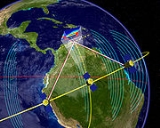
Neutral Ion Coupling Explorer
Encyclopedia

NASA
The National Aeronautics and Space Administration is the agency of the United States government that is responsible for the nation's civilian space program and for aeronautics and aerospace research...
. The goal of the NICE mission is to answer the question: How do neutral dynamics drive ionospheric variability? NICE will approach this goal with three targeted investigations of neutral-ion coupling:
- How do large-scale atmospheric waves control the ionosphereIonosphereThe ionosphere is a part of the upper atmosphere, comprising portions of the mesosphere, thermosphere and exosphere, distinguished because it is ionized by solar radiation. It plays an important part in atmospheric electricity and forms the inner edge of the magnetosphere...
at low latitudes? - What causes the day-to-day variability in the low- latitude ionosphere observed by plasma drift measurements?
- During magnetic storms, what causes the enhancement of ionospheric plasma at low latitudes?
Mission definition
NICE will discover how winds and composition of the upper atmosphere drive the electric fields and chemical reactions that control Earth's ionosphere. The mission will resolve competing theories about the low-latitude ionospheric dynamo, and will explain how large-scale waves from the lower atmosphere can couple to the ionosphere and upper atmosphere. Understanding neutral-ion coupling in Earth's atmosphere has applications for solar and planetary atmospheres including Mars and Jupiter. NICE will be the first mission to simultaneously measure all the key parameters that both characterize and drive the ionosphere. It will remotely measure the neutral wind, temperature, composition, atmospheric and ionospheric density distributions as well as make in situIn situ
In situ is a Latin phrase which translated literally as 'In position'. It is used in many different contexts.-Aerospace:In the aerospace industry, equipment on board aircraft must be tested in situ, or in place, to confirm everything functions properly as a system. Individually, each piece may...
measurements of the ion motion. NICE uses flight-tested science instruments in a low-inclination orbit where the geometry magnetically links the in situ and remote sensing
Remote sensing
Remote sensing is the acquisition of information about an object or phenomenon, without making physical contact with the object. In modern usage, the term generally refers to the use of aerial sensor technologies to detect and classify objects on Earth by means of propagated signals Remote sensing...
measurements.

